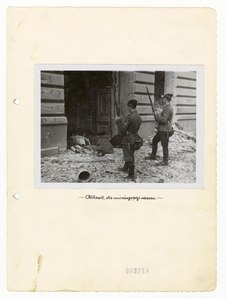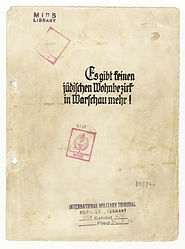File:Askaris im Warschauer Getto - 1943.jpg

Archivo original (1816 × 1319 píxeles; tamaño de archivo: 645 kB; tipo MIME: image/jpeg)
Leyendas
Leyendas
Resumen
[editar]| Fotógrafo |
DesconocidoUnknown author (Franz Konrad confessed to taking some of the photographs, the rest was probably taken by photographers from Propaganda Kompanie nr 689.[1][2]) |
|
| Descripción original |
descripciones originales de las imágenes, que pueden ser erróneas, sesgadas, estar obsoletas o tener una orientación política. alemán: Askaris, die mit eingesetzt waren Askaris assigned to the operation title QS:P1476,de:"Askaris, die mit eingesetzt waren"
label QS:Lde,"Askaris, die mit eingesetzt waren"
label QS:Len,"Askaris assigned to the operation"
label QS:Lpl,"Askarzy, z którymi współdziałano" |
|
| Descripción |
Deutsch: Zwei Askaris oder Trawnikis als Vertreter sog. „fremdvölkischer Hilfseinheiten“ der SS stehen vor den Leichen getöteter Juden in einem Hauseingang im Warschauer Ghetto.
English: Two "Askaris" or "Trawnikis" as representatives of the so-called "foreign subsidiary ethnic divisions" SS before the corpses of Jews in the doorway of the Warsaw Ghetto. The unit trained in village of Trawniki was made up of Ukrainians, Russians, Belorussians, Poles, Estonians, Lithuanians, Latvians, ethnic Germans, Kazakhs and Tartars.
Polski: Dwóch żołnierzy kolaboranckich jednostek pomocniczych przy ciałach zamordowanych Żydów przed kamienicą przy Kupieckiej 18. Stroop nazywał te jednostki askarysami, co było aluzją do walczących za Cesarza Wilhelma II żołnierzy tubylców w koloniach niemieckich. W tłumieniu getta uczestniczyły pomocnicze oddziały ukraińskie i łotewskie. W tym drugim przypadku były to dwa bataliony łotewskiej policji (22 i 272).[3] Także batalion sowieckich jeńców wojennych znany jako Trawniki-Männer lub SS-Streibelbataillon Trawniki-Männer brał udział w w likwidacji getta warszawskiego. |
|
| Lugar representado | Zamenhofa 42 / Kupiecka 18 [4] | |
| Fecha |
entre 19 de abril de 1943 y 16 de mayo de 1943 date QS:P571,+1943-00-00T00:00:00Z/9,P1319,+1943-04-19T00:00:00Z/11,P1326,+1943-05-16T00:00:00Z/11 |
|
| Número de inventario | ||
| Referencias |
|
|
| Fuente | https://research.archives.gov/description/6003996 | |
| Otras versiones |
|
Libro
[editar]| The Jewish Quarter of Warsaw is No More!
|
||||||||||||||||||||||||||||||||||||||||||||||||||
|---|---|---|---|---|---|---|---|---|---|---|---|---|---|---|---|---|---|---|---|---|---|---|---|---|---|---|---|---|---|---|---|---|---|---|---|---|---|---|---|---|---|---|---|---|---|---|---|---|---|---|
| Autor | ||||||||||||||||||||||||||||||||||||||||||||||||||
| Título |
alemán: Es gibt keinen jüdischen Wohnbezirk in Warschau mehr! The Jewish Quarter of Warsaw is No More! title QS:P1476,de:"Es gibt keinen jüdischen Wohnbezirk in Warschau mehr!"
label QS:Lde,"Es gibt keinen jüdischen Wohnbezirk in Warschau mehr!"
label QS:Len,"The Jewish Quarter of Warsaw is No More!"
label QS:Lpl,"Żydowska dzielnica mieszkaniowa w Warszawie już nie istnieje!" |
|||||||||||||||||||||||||||||||||||||||||||||||||
| Descripción |
Deutsch: Niederschlagung des Aufstandes im Warschauer Ghetto. Foto von Jürgen Stroop in einem Bericht an Heinrich Himmler vom Mai 1943.
English: Stroop Report: a report written by Jürgen Stroop for Heinrich Himmler about liquidation of Warsaw Ghetto in May 1943.
Polski: Raport Stroopa: raport z maja 1943, napisany przez Jürgena Stroopa do Heinricha Himmlera na temat likwidacji getta warszawskiego.
עברית: דו"ח סטרופ, נכתב על ידי יורגן סטרופ להיינריך הימלר על דיכוי המרד בגטו ורשה במאי 1943 |
|||||||||||||||||||||||||||||||||||||||||||||||||
| Idioma | alemán | |||||||||||||||||||||||||||||||||||||||||||||||||
| Colección |
NARA copy:
institution QS:P195,Q518155
Warsaw copy:
institution QS:P195,Q705173 |
|||||||||||||||||||||||||||||||||||||||||||||||||
| Número de inventario | ||||||||||||||||||||||||||||||||||||||||||||||||||
| Fecha de publicación |
mayo de 1943 date QS:P,+1943-05-00T00:00:00Z/10 |
| Dimensiones |
altura: 30 cm; ancho: 22 cm dimensions QS:P2048,30U174728 dimensions QS:P2049,22U174728 |
| Historial de la pieza |
|
| Referencias |
Text of the report and the photographs can be found at:
|
| Fuente |
Este archivo no tiene información sobre su origen.
Edita la descripción del archivo y proporciona una fuente. |
Licencia
[editar]| Public domainPublic domainfalsefalse |
Esta fotografía es de dominio público porque según el Art. 3 de la ley de derechos de autor del 29 de marzo de 1926 de la República de Polonia y el Art. 2 de la ley de derechos de autor del 10 de julio de 1952 de la República Popular de Polonia, todas las fotografías de fotógrafos polacos (o publicadas por primera vez en Polonia o simultáneamente en Polonia y en el extranjero) publicadas sin un aviso claro de derechos de autor antes de que se cambiara la ley, el 23 de mayo de 1994, se supondrán que son de dominio público en Polonia.
Esta obra se encuentra en el dominio público en los Estados Unidos porque cumple tres requisitos:
Para quien suba el archivo: Por favor proporcione dónde y cuándo se publicó la imagen por primera vez.
|
 |
| Public domainPublic domainfalsefalse |
Esta imagen (u otro archivo multimedia) se encuentra en el dominio público porque sus derechos de autor han expirado y su autor es anónimo.
Esto se aplica a la Unión Europea y a aquellos países con un plazo de derechos de autor de 70 años desde que la obra se puso a disposición del público y el autor nunca reveló su identidad. Importante: mencione siempre la procedencia de la imagen, en la medida de lo posible, y asegúrese de que el autor nunca reclamó su autoría. Nota: En Alemania y posiblemente en otros países, ciertas obras anónimas publicadas antes del 1 de julio de 1995 tienen derechos de autor hasta 70 años después de la muerte del autor. Véase Übergangsrecht. Por favor, utilice esta plantilla sólo si el autor nunca reclamó la autoría o su autoría nunca se hizo pública de ninguna otra manera. Si la obra es anónima o seudónima (por ejemplo, publicada sólo bajo el nombre de una empresa u organización), utilice esta plantilla para las imágenes publicadas hace más de 70 años.
Para una obra que se haya hecho pública en el Reino Unido, utilice en su lugar Template:PD-UK-unknown.
|
| Public domainPublic domainfalsefalse |
| This work is considered public domain in the United States because its copyright was owned or administered by the Alien Property Custodian and the copyright in the source country is or was owned by a government or instrumentality thereof. The above provision is contained in 17 U.S.C. § 104A(a)(2).
Public domain works must be out of copyright in both the United States and in the source country of the work in order to be hosted on the Commons. This file must have an additional copyright tag indicating the copyright status in the source country. |

|

|
Esta imagen ha sido evaluada según los criterios de imágenes valiosas y es considerada la imagen más preciada en Wikimedia Commons en el ámbito de aplicación: Auxiliaries during the Warsaw Ghetto Uprising. Para mayor información, puede ver su nominación en está página (en inglés): Commons:Valued image candidates/Askaris im Warschauer Getto - 1943.jpg. |
Historial del archivo
Haz clic sobre una fecha y hora para ver el archivo tal como apareció en ese momento.
| Fecha y hora | Miniatura | Dimensiones | Usuario | Comentario | |
|---|---|---|---|---|---|
| actual | 12:08 11 oct 2013 |  | 1816 × 1319 (645 kB) | Jarekt (discusión | contribs.) | higher resolution image from http://research.archives.gov/description/6003996#18 |
| 08:07 10 abr 2007 |  | 638 × 450 (113 kB) | Jaro.p~commonswiki (discusión | contribs.) | Two Ukrainian members of the SS, known as "Askaris," peer into a doorway past the bodies of Jews killed during the suppression of the Warsaw ghetto uprising. The original German caption reads: "Askaris used during the operation." Photo credit: Polish Nat |
No puedes sobrescribir este archivo.
Usos del archivo
Las siguientes páginas usan este archivo:
- Getto warszawskie
- Lokalizacja fotografii kolekcji Stroopa
- Stroop Report
- Warsaw Ghetto Uprising
- User talk:Buidhe
- Commons:Valued image candidates/Askaris im Warschauer Getto - 1943.jpg
- File:Askaris im Warschauer Getto - 1943.jpg
- File:Ukrainiannaziatrocity2.jpg (archivo de redirección)
- Category:Trawniki concentration camp
Uso global del archivo
Las wikis siguientes utilizan este archivo:
- Uso en af.wikipedia.org
- Uso en ar.wikipedia.org
- Uso en be-tarask.wikipedia.org
- Uso en be.wikipedia.org
- Uso en ca.wikipedia.org
- Uso en cs.wikipedia.org
- Uso en de.wikipedia.org
- Uso en en.wikipedia.org
- Uso en eo.wikipedia.org
- Uso en es.wikipedia.org
- Uso en et.wikipedia.org
- Uso en fa.wikipedia.org
- Uso en fr.wikipedia.org
- Uso en he.wikipedia.org
- Uso en hy.wikipedia.org
- Uso en it.wikipedia.org
- Uso en ja.wikipedia.org
- Uso en ksh.wikipedia.org
- Uso en lv.wikipedia.org
- Uso en nn.wikipedia.org
- Uso en no.wikipedia.org
Ver más uso global de este archivo.
Metadatos
Este archivo contiene información adicional, probablemente añadida por la cámara digital o el escáner usado para crearlo o digitalizarlo.
Si el archivo ha sido modificado desde su estado original, pueden haberse perdido algunos detalles.
| Título de la imagen |
|
|---|---|
| Fabricante de la cámara | Epson |
| Modelo de cámara | Exp10000XL10000 |
| Fecha y hora de la generación de los datos | 06:39 22 dic 2010 |
| Título breve |
|
| Anchura | 5887 px |
| Altura | 7739 px |
| Bits por componente |
|
| Esquema de compresión | Sin comprimir |
| Composición de pixel | RGB |
| Orientación | Normal |
| Número de componentes | 3 |
| Distribución de datos | formato panorámico |
| Software usado | Adobe Photoshop CS4 Windows |
| Fecha y hora de modificación del archivo | 09:50 14 jul 2011 |
| Fecha y hora de la digitalización | 06:39 22 dic 2010 |
| Fecha y hora de la generación de los datos (precisión por debajo del segundo) | 00 |
| Fecha y hora de la digitalización (precisión por debajo del segundo) | 00 |
| Palabras clave |
|
Datos estructurados
Elementos representados en este archivo
representa a
image/jpeg
7c13412b230e2459f2b0fab63653f2c020ae9bc1
660 686 byte
1319 píxel
1816 píxel
- Stroop Report
- Auxiliaries during the Warsaw Ghetto Uprising
- Side caps of Nazi Germany
- Field caps Wehrmacht
- People with corpses
- Military uniforms of World War II
- Irregular units, guerrilla warfare and counter-insurgency during World War II
- Warsaw Ghetto photos from Zamenhofa Street
- German canteens
- Holocaust in Warsaw
- Holocaust victims
- Executions by shooting
- Trawniki men
- Pages with non-numeric formatnum arguments
- Template Unknown (author)
- Images without source
- Artworks without Wikidata item
- PD-Poland
- PD-anon-70-EU
- PD US alien property
- Images from the United States Holocaust Memorial Museum
- Valued images sorted by promotion date
- Valued images promoted 2020-03
- Valued images missing SDC source of file
- Valued images missing SDC copyright status
- Valued images missing SDC copyright license
- Valued images missing SDC depicts
- Valued images missing SDC creator
- Valued images missing SDC inception



